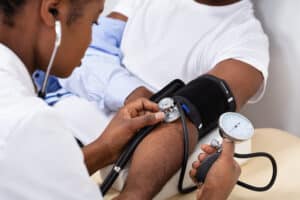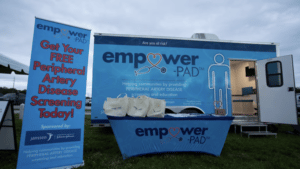 One of the Amputee Coalition’s main pillars encompasses education on preventing limb loss to help bridge the gap in racial and ethnic disparities in the limb loss community. Black Americans are disproportionately affected by peripheral artery disease (PAD). According to the American Heart Association’s Circulation Research Journal, Black Americans are twice as likely than white Americans to have blockages in the blood vessels that can lead to PAD. [1]
One of the Amputee Coalition’s main pillars encompasses education on preventing limb loss to help bridge the gap in racial and ethnic disparities in the limb loss community. Black Americans are disproportionately affected by peripheral artery disease (PAD). According to the American Heart Association’s Circulation Research Journal, Black Americans are twice as likely than white Americans to have blockages in the blood vessels that can lead to PAD. [1]
Peripheral artery disease (PAD) is a chronic condition that causes the narrowing of the arteries that carry blood away from the heart to other parts of the body. The most common type of PAD affects the lower extremities, in which blood flow to the legs and feet reduces, leading to amputation. [2] 8.5 million people in the U.S. have been diagnosed with PAD. Still, up to 20 million people may unknowingly have the condition because the disease can often be asymptomatic. [3]
“Black Americans are also 25 percent less likely to receive a medical procedure to restore the blood flow to their legs before an amputation. Blacks and Hispanics historically have less access to quality, vascular healthcare.” — Richard Browne, M.D., Senior Medical Executive, Cardiovascular and Metabolism Medical Affairs, Janssen Pharmaceuticals [4]
The Janssen Pharmaceutical Companies of Johnson & Johnson has launched a new initiative, “Save Legs. Change Lives. Spot Peripheral Artery Disease Now“. The program aims to provide education and awareness around the hidden threat of peripheral artery disease (PAD)-related amputation. The focus aims to reach Black Americans, who are more likely to have asymptomatic PAD.
 Empower-PAD, Janssen’s mobile health unit, is mobilizing through community outreach events in vulnerable communities and bringing PAD screening and patient education directly to communities nationwide. Empower-PAD provides testing for PAD using ankle brachial index or ABI testing. ABI is a simple test that compares blood pressure in the upper and lower limbs. Health care providers calculate ABI by comparing the blood pressure in an artery of the ankle with the blood pressure in an artery of the arm. [5]
Empower-PAD, Janssen’s mobile health unit, is mobilizing through community outreach events in vulnerable communities and bringing PAD screening and patient education directly to communities nationwide. Empower-PAD provides testing for PAD using ankle brachial index or ABI testing. ABI is a simple test that compares blood pressure in the upper and lower limbs. Health care providers calculate ABI by comparing the blood pressure in an artery of the ankle with the blood pressure in an artery of the arm. [5]
The American Heart Association cites the most common symptoms of PAD include cramping, fatigue, pain, or discomfort in the leg or hip muscles while walking or climbing stairs. If you think you may be at risk of peripheral artery disease (PAD), talk with your healthcare provider about what you can do to avoid limb loss.
To learn more about the Empower-PAD program and community events near you, visit their website at https://www.iamempowerpad.com/.
[1] Racial and Ethnic Disparities in Peripheral Artery Disease | Circulation Research. (ahajournals.org)
[2] What is Peripheral Artery Disease (PAD)? | American Heart Association. https://www.heart.org/en/health-topics/peripheral-artery-disease/about-peripheral-artery-disease-pad
[3] American Heart Association. PAD Toolkit for Health Care Professionals. https://www.heart.org/en/health-topics/peripheral-artery-disease/pad-toolkit
[4] Screening Event Targets Hidden Threat of Amputation Related to Peripheral Artery Disease (PAD) | Johnson & Johnson. https://www.jnj.com/our-race-to-health-equity/screening-event-targets-hidden-threat-of-amputation-related-to-peripheral-artery-disease-pad
[5] Ankle Brachial Index Test | Johns Hopkins Medicine. https://www.hopkinsmedicine.org/health/treatment-tests-and-therapies/ankle-brachial-index-test

